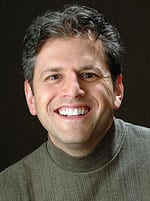Life Extension Magazine®
When Suzanne Somers came out with her book The Sexy Years, the world stood up and took notice. Once dismissed as a ditzy blonde because of her role on Three’s Company, she proved that she was quite the opposite, winning a valiant battle against breast cancer and receiving kudos worldwide for her well-researched and inspirational book. Yet until recently, one of the doctors who helped shape her views on hormone replacement remained relatively obscure. This has now changed with the publication of Perfect Balance, a motivational look at how you can achieve your ideal hormone balance through a combination of diet, exercise, supplementation, and hormone replacement. Different Perspectives, Common Goal“Suzanne and I have the same publisher,” notes Robert Greene, MD. “One day she called my office, said she had heard about a book I was working on, and asked if we could talk about hormones. That first conversation lasted over an hour and led to several more conversations and emails. Ultimately, she asked me if I would write the foreword for her book The Sexy Years. I felt it was an honor to support her efforts at patient advocacy and promoting health through correcting hormone imbalance. As a highly successful career woman and breast cancer survivor, she speaks with a very loud voice. As a scientist, educator, and health care provider, I feel privileged to be able to share cutting-edge research findings with her. As individuals, we each bring a different perspective that supports the same common goal.”
Dr. Greene has been involved in hormone therapy for many years. He completed his subspecialty training at a time when brain imaging was becoming a practical tool for gathering information on how people experience the world around them. He decided to begin studying the symptoms that women often experience when going through hormone shifts, such as during the premenstrual period, postpartum, and during the transition into menopause. The information was staggering . . . and very practical. “I proved that symptoms do matter,” says Dr. Greene. “Supported by the knowledge that uncorrected hormone imbalance triggers symptoms, I came to realize that when we feel, function, and look our best, it’s because our hormones are all working together toward a common goal. Best of all, when we correct an imbalance, we’re providing relief by treating the problem rather than masking it. This is a very important concept for men and women of all ages. Admittedly, women have more abrupt and dramatic hormone shifts than men typically experience. But to a man who’s experiencing symptoms, this information is every bit as important as it is to a woman of any age whose health and wellness have been compromised by hormone imbalance.” Individualized TreatmentDr. Greene has been involved in research on the hormone-brain connection for nearly 15 years. He also delivers around 100 lectures a year to health care providers and scientists across the country. His book now provides the public with the same cutting-edge information, allowing people to take a more proactive role in their own care. Greene’s research clearly shows that hormone treatment corrects the cause of symptoms rather than masking the problem as other treatments do. During the first office visit, Greene focuses on getting to know the patient. “I try to discover what they’ve been experiencing, how long their problem has been going on, what (if any) treatments they’ve tried, what their goals are, and what their personal bias is,” he explains. “Much of this information can be obtained through questionnaires or notes that they can provide me even before we sit down together. Based on that information, I’ll perform an examination and testing—if indicated—and then provide a prioritized list of treatment options. I’ll present the advantages and disadvantages of each treatment option. They’ll choose which option is most appealing to them, with the knowledge that other options remain if the first one doesn’t meet their needs. The key is to let them choose the symptoms that are most distressing to them. I have found that this approach allows my agenda, which is promoting exercise, healthy diet, and healthy lifestyle, to naturally become part of the solution.”
Greene encourages most of his patients to meet with a nutritionist who works in his office. He gears his dietary recommendations to each patient’s hormone status, goals, and personal preferences. He also makes lifestyle and exercise recommendations according to each person’s age, ability, and willingness to make changes. Then he provides a hormone regimen that encourages them to adjust the dosage of only one hormone at a time. The goal is for the patient to have the opportunity to “try on” different doses or regimens. He likens this approach to being able to take a pair of shoes home and wear them for awhile before making a commitment to buying them. “Admittedly, this sort of individualized approach isn’t always conducive to a typical general-care practice,” notes Greene. “That’s why I wrote Perfect Balance, with the goal of empowering readers to be proactive. They can now take this approach with them during the next office visit to their local provider. Since it’s so well supported by today’s research, I find that most busy health care practitioners embrace it because it actually makes their job easier while improving patient satisfaction.” An Integrative ApproachWhile most people understand that hormone levels decline with age, few recognize the impact that food choices have on your hormone supply. Too many people put little thought into what, when, or how much they eat. Greene believes that excess consumption of calories, not getting enough water, low fiber intake, and consuming too many processed foods are common problems in our society that have contributed dramatically to the health problems associated with aging. He believes that excess calorie intake increases free radical production due to the aerobic metabolism of the food, which promotes aging. As a result, he recommends consuming more antioxidants and suggests taking them with food. At the same time, he believes that too little fat reduces testosterone levels, so you need a balance of protein, carbohydrates, and fat in the diet. Also, protein stimulates the release of growth hormone, while the B vitamins promote ideal neurotransmitter levels. Greene emphasizes the negative impact of what he calls bio-mutagens in our environment: “These bio-mutagens are the food additives, contaminants, and toxins that are frequent ingredients in what we eat. I give them this name because toxicologists classify most of these as hormone-disrupting agents. Simple steps that you can take to reduce bio-mutagen exposure are to seek organic food choices, carefully select food preparation methods that don’t create them, and use a water filter on your preferred tap to remove them from your drinking water. The body often can’t break down these foreign molecules, so they can build up and produce problems.”
Greene also recognizes the negative effect that our modern sedentary lifestyle has on hormone levels. He believes that many of our hormone imbalances today are worsened by the fact that we spend most of our day sitting. He therefore encourages patients to pursue a three-pronged approach that includes endurance exercise, strength training, and flexibility training. Endurance activities are what many refer to as aerobics, and include walking, running, cycling, and dancing. While promoting oxygen exchange, they also promote coordination. Aerobic activity should be done each day, even if it means nothing more than using stairs instead of an elevator or parking a bit farther away from your destination. These activities can improve insulin sensitivity and increase erythropoietin, which is the hormone that boosts red blood cell formation. Strength training promotes muscle growth and joint stability. Finally, flexibility training, such as yoga, tai chi, and Pilates, reduces stress-hormone levels by triggering the body’s relaxation response. As far as supplementation is concerned, he focuses on the nutrients that most greatly promote brain health and hormone balance. He always reminds his patients that, as their name implies, they are meant to supplement a healthy diet. As a result, he recommends the ones that are commonly lacking from the food supply. He is most excited about the omega-3 fatty acids and curcumin, which have anti-inflammatory benefits, as well as L-carnitine, which is essential for the metabolism of fats in the mitochondria (the energy factories of the cell). Other hormone-friendly supplements are coenzyme Q10 and fiber. Also on his list is vitamin D, a fat-soluble nutrient that is good for the bones and also may help promote balance and coordination.
Feeling Your BestGreene always reminds his patients that the brain is the controlling force of your hormone balance: “The brain not only influences how you feel but also your susceptibility to illness and your ability to repair damage and injury (including from normal wear and tear), as well as how you project yourself to others. We are a very social species, and we are driven by emotions. So I encourage everyone to avoid isolation and participate in group activities. In fact, one of the harshest penalties that our society imposes on criminals is solitary confinement, and yet many of our mature citizens inflict this on themselves. The other tip that modern brain science has taught us is that we love novelty and that we never lose the ability to learn. So keep trying new activities, foods, and experiences. Finally, the brain exhibits a use-it-or-lose-it phenomenon, just like your muscles do. Do puzzles, play chess, keep reading, learn new hobbies, and most important, find ways to laugh a lot. The best way to overcome age-related prejudice is to get out and serve as an example that maintaining hormone balance is the key to wellness and longevity.” Over the years, Greene has helped many couples as they work through their hormone imbalances. He has found that the best way to approach any hormone-related problem is together—as a team. He developed this insight while practicing his other specialty—infertility—and has found that it carries over into problems related to sexuality, aging, mood disorders, and even problems like diabetes and obesity. To begin with, validating symptoms helps overcome any possible stigma, so it is best when couples become educated about one another’s situation. His experience in brain research has helped him to fully appreciate that when problems occur, men and women often communicate differently. Informing couples of this research often fosters empathy and awareness between them and reduces miscommunication. His entire process is based on education and mutual understanding. “The greatest opportunity that everyone has to feel their best each and every day is through hormone balance,” Greene concludes. “Therefore, it’s never too late to achieve or re-establish hormone balance. Equally important, your ability to remain functional and independent is linked to this wellness. So supplementing your natural decline in hormone production provides the most healthful and, arguably, the most natural strategy to maintaining your vigor as you age. There is no hormone that your body makes that will harm you while making you feel better. That’s not true of drugs. So let your symptoms be your guide and don’t settle for anything less than perfect balance.” Dr. Greene is the author of Perfect Balance (Clarkson Potter, 2005), and can be reached via email at DrRobertGreene@aol.com. |





